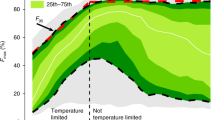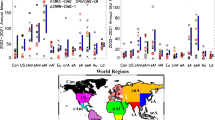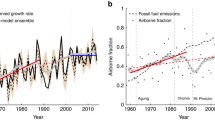Abstract
Global climate change as currently simulated could result in the broad-scale redistribution of vegetation across the planet. Vegetation change could occur through drought-induced dieback and fire. The direct combustion of vegetation and the decay of dead biomass could result in a release of carbon from the biosphere to the atmosphere over a 50- to 150-year time frame. A simple model that tracks dieback and regrowth of extra-tropical forests is used to estimate the possible magnitude of this carbon pulse to the atmosphere. Depending on the climate scenario and model assumptions, the carbon pulse could range from 0 to 3 Gt of C yr−1. The wide range of pulse estimates is a function of uncertainties in the rate of future vegetation change and in the values of key model parameters.
Similar content being viewed by others
References
Allen, L.H. Jr., (1990) ‘Plant responses to rising carbon dioxide and potential interactions with air pollutants’, J. Environ. Qual. 19, 15–34.
Auclair, A.N.D. (1985) ‘Postfire regeneration of plant and soil organic pools in a Picea mariana-Cladonia stellaris ecosystems’, Can. J. For. Res. 15, 279–291.
Bolin, B. (1983) ‘The carbon cycle’, in The Major Biogeochemical Cycles and Their Interactions, SCOPE Report No. 21. John Wiley, Chichester, pp. 41–45.
Bolin, B. (1986) ‘How much CO2 will remain in the atmosphere’, in B. Bolin, B.R. Döös, J. Jäger, and R.A. Warrick (eds.), The Greenhouse Effect, Climatic Change, and Ecosystems, John Wiley & Sons, Chichester, pp. 93–155.
Bonan, G.B. and Shugart, H.H. (1989) ‘Environmental factors and ecological processes in boreal forests’, Ann. Rev. Ecol. Syst. 20, 1–28.
Bonan, G.B., H.H. Shugart, and D.L. Urban. 1990. ‘The sensitivity of some high-latitude boreal forests to climatic parameters’, Clim. Change 16, 9–29.
Bormann, F.H. and G.E. Likens. (1979) Pattern and process in a forested ecosystem. Springer-Verlag, New York.
Botkin, D.B. and Simpson, L.G. (1990) ‘Biomass of the North American boreal forest’, Biogeochem. 9, 161–174.
Cofer, W.R., III, Levine, J.S., Winstead, E.L. and Stocks, B.J. (1990) ‘Gaseous emissions from Canadian boreal forest fires’, Atmos. Environ. 24A, 1653–1659.
Davis, M.B. (1986) ‘Climatic instability, time lags, and community disequilibrium’, in J. Diamond and T.J. Case (eds.), Community Ecology, Harper and Row, NY.
Daubenmire, R. (1968) ‘Soil moisture in relation to vegetation distribution in the mountains of Northern Idaho’, Ecology 49, 431–438.
Dickinson, R.E. (1983) ‘Land surface processes and climate — surface albedos and energy balance’, Adv. Geophys. 25, 305–353.
Dixon, R. and Turner, D.P. (1991) ‘The global carbon cycle and climate change: responses and feedbacks from below-ground systems’, Environ. Poll. 73, 245–262.
Dolph, J., D. Marks, and King, G.A. (In press) ‘Sensitivity of the regional water balance in the Columbia River Basin to climate variability: Application of a spatially distributed water balance model’, in R.J. Naiman (ed.), Watershed Management: Balancing Sustainability with Environmental Change, Springer-Verlag. New York, NY, U.S.A.
Edmonds, R.L. (1987) ‘Decomposition rates and nutrient dynamics in small-diameter woody litter in four forest ecosystems in Washington, U.S.A.’, Can. J. For. Res. 17, 499–509.
Emanuel, W.R., Shugart, H.H., and Stevenson, M.P. (1985a) ‘Climatic change and the broad-scale distribution of terrestrial ecosystem complexes’, Clim. Change 7, 29–43
Emanuel, W.R., Shugart, H.H., and Stevenson, M.P. (1985b) ‘Response to comment: Climatic change and the broad-scale distribution of terrestrial ecosystem complexes’, Clim. Change 7, 457–460.
Fahnestock, G.R. and J.K. Agee. (1983) ‘Biomass consumption and smoke production by prehistoric and modern forest fires in Western Washington’, J. For. 81, 653–657.
Foster, J.R. and Lang, G.E. (1982) ‘Decomposition of red spruce and balsam fir boles in the White Mountains of New Hampshire’, Can. J. For. Res. 12, 617–626.
Gleick, P.H. (1987a) ‘Regional hydrologic consequences of increases in atmospheric CO2 and other trace gases’, Clim. Change 10, 137–161.
Gleick, P.H. (1987b) ‘The development and testing of a water balance model for climate impact assessment: modeling the Sacramento Basin’, Water Resources Res. 23, 1049–1061.
Gucinski, H., Marks, D., and Turner, D.P., (editors) (1990) Biospheric Feedbacks to Climate Change: The Sensitivity of Regional Trace Gas Emissions, Evapotranspiration, and Energy Balance to Vegetation Redistribution, Status of Ongoing Research, U.S. Environmental Protection Agency. EPA/600/3-90/078.
Hansen, J., Fung, I., Lacis, A., Rind, D., Lebedeff, S., Ruedy, R., and Russell, G. (1988) ‘Global climate changes as forecast by Goddard Institute for Space Studies three-dimensional model’, J. Geophys. Res. 93, 9341–9364.
Harmon, M.E., J.F. Franklin, F.J. Swanson, P. Sollins, S.V. Gregory, J.D. Lattin, N.H. Anderson, S.P. Cline, N.G. Aumen, J.R. Sedell, G.W. Lienkaemper, K. Cromack, Jr., and K.W. Cummins. (1986) ‘Ecology of coarse woody debris in temperate ecosystems’, Adv. Ecol. Res. 15, 133–302.
Holdridge, L.R. (1947) ‘Determination of world formulations from simple climatic data’, Science 105, 367–368.
Holdridge, L.R. (1967) Life Zone Ecology, Tropical Science Center, San Jose, PR.
Houghton, R.A. 1990. ‘The global effects of tropical deforestation’, Environ. Sci. Tech. 24, 414–422.
Intergovernmental Panel on Climatic Change (IPCC). (1990) Scientific Assessment of Climate Change, Report for WGI Plenary Meeting. Cambridge University Press, Cambridge, UK.
Jenkinson, D.S., Adams, D.E. and Wild, A. (1991) ‘Model estimates of CO2 emissions from soil in response to global warming’, Nature 351, 304–306.
King, G.A., Winjum, J.K., Dixon, R.K., and Arnaut, L.Y, (editors). (1990) Response and Feedbacks of Forest Systems to Global Climate Change, US Environmental Protection Agency, Corvallis, OR, USA, EPA/600/3-90/080.
Lashof, D.A. (1989) ‘The dynamic greenhouse: Feedback processes that may influence future concentrations of atmospheric trace gases and climatic change’, Clim. Change 14, 213–242.
Lettenmaier, D.P., and Gan, T.Y. (1990) ‘Hydrologic sensitivities of the Sacramento-San Joaquin river basin, California, to global warming’, Water Resources Res. 26, 69–87.
Levine, J.S. (1990) Global biomass burning: Atmospheric, climatic and biospheric implications. Eos 11, 1075–1077.
Manabe, S., and Wetherald, R.T. (1987) ‘Large-scale changes in soil wetness induced by an increase in carbon dioxide’, J. Atmos. Sci. 44, 1211–1235.
Marland, G., A. Boden, R.C. Griffin, S.F. Huang, P. Kanciruk, and T.R. Nelson. (1989) Estimates of CO2 emissions from fossil fuel burning and cement manufacturing, based on the United Nations energy statistics and the U.S. Bureau of Mines cement manufacturing data. ORNL/CDIAC-25. Oak Ridge National Laboratory, Oak Ridge, Tennessee.
Mitchell, J.F.B. (1989) ‘The “greenhouse” effect and climate change’, Rev. Geophys. 27(1), 115–139.
Neilson, R.P., and King, G.A. (In press) ‘Continental scale biome responses to climatic change’, in D. McKenzie, E. Hyatt, and J. MacDonald, (eds.), Proceedings of International Symposium: Ecological Indicators. Ft. Lauderdale, FL, Oct. 16–19, 1990, Elsevier Science Publishers, Ltd.
Neilson, R.P., King, G.A., and Koerper, G. (In press) ‘Toward a rule-based biome model’, Lands. Ecol.
Neilson, R.P., King, G.A., DeVelice, R.L., Lenihan, J., Marks, D., Dolph, J., Campbell, B., and Click. G. (1989) Sensitivity of Ecological Landscapes and Regions to Global Climate Change. EPA/600/3-89/073, NTIS-PB90-120-072/AS, Washington D.C.
Neilson, R. P., G.A. King, R.L. DeVelice, and J.M. Lenihan. (1992) ‘Regional and local vegetation patterns: the responses of vegetation diversity to subcontinental air masses’, In: Landscape Boundaries: Consequences for Biotic Diversity and Ecological Flows (Ecological Studies 92). Proceedings of Scientific Committee on Problems of the Environment, International Council of Scientific Unions, Workshop on Ecotones, edited by A. Hansen and F. di Castri. Springer-Verlag, New York.
Olson, J.S. (1963). ‘Energy storage and the balance of producers and decomposers in ecological systems’, Ecology 44, 322–331.
Olson, J.S.. Watts, J.A., and Allison, L.J. (1983) Carbon in Live Vegetation of Major World Ecosystems, ORNL-5862, Oak Ridge National Laboratory, Oak Ridge, TN., USA.
Overpeck, J.T., Rind, D., and Goldberg, R. (1990) ‘Climate-induced changes in forest disturbance and vegetation’, Nature 343, 51–53.
Post, W.M., Emanuel, W.R., Zinke, P.J., and Stangenberger, A.G. (1982) ‘Soil carbon pools and world life zones’, Nature 298, 156–159.
Post, W.M., Peng, T-H., Emanuel, W.R., King, A.W., Dale, V.H., and DeAngelis, D.L. (1990) ‘The global carbon cycle’, Am. Scientist 78, 310–326.
Prentice, K.C. (1990) ‘Bioclimatic distribution of vegetation for General Circulation Model studies’, J. Geophys. Res. 95, 11811–11830.
Prentice, K.C., and Fung, I.Y. (1990) ‘Bioclimatic simulations test the sensitivity of terrestrial C storage to perturbed climates’, Nature 346, 48–51.
Prentice, I.C., Sykes, M.T., and Cramer, W. (1991) ‘The possible dynamic response of northern forests to global warming’, Global Ecol. Biogeog. Lett, 1, 129–135.
Schlesinger, M.E., and Zhao, Z.C. (1989) ‘Seasonal climatic change introduced by doubled CO2 as simulated by the OSU atmospheric GCM/mixed-layer ocean model’, J. Climate 2, 429–495.
Smith, J.B., and Tirpak, D. (editors). (1989) The Potential Effects of Global Climate Change on the United States, Report to Congress, EPA-230-05-89-050, U.S. Environmental Protection Agency, Washington, DC, USA.
Smith, T.M., Shugart, H.H., Bonan, G.B., and Smith, J.B. (1991) ‘Modeling the potential response of vegetation to global climate change’. Adv. Ecol. Res. 22, 93–116.
Smith, T.M., Leemans, R., and Shugart, H.H. (In press) ‘Sensitivity of terrestrial carbon storage to in2 induced climate change: comparison of four scenarios based on general circulation models’, Clim. Change.
Stephenson, N.L. (1990) ‘Climatic control of vegetation distribution: the role of the water balance’. Amer. Nat. 135, 649–670.
U.S. West. (1988) Hydrodata user's manual: USGS daily and peak values. Version 2.0. US West Optical Publishing, Denver, Colorado.
Waring, R. H. and W.H. Schlesinger. (1985) Forest Ecosystems, Concepts and Management. Academic Press, Inc., Harcourt Brace Jovanovich, Publishers. Orlando.
Whittaker, R.H, (1975) Communities and Ecosystems, 2nd Edition, MacMillan Publishing Co., Inc., New York, NY, USA.
Woodward, F.I. (1987) Climate and Plant Distribution, Cambridge University Press, London, England.
Author information
Authors and Affiliations
Rights and permissions
About this article
Cite this article
King, G.A., Neilson, R.P. The transient response of vegetation to climate change: A potential source of CO2 to the atmosphere. Water Air Soil Pollut 64, 365–383 (1992). https://doi.org/10.1007/BF00477111
Issue Date:
DOI: https://doi.org/10.1007/BF00477111




